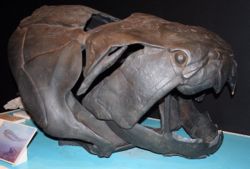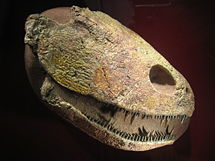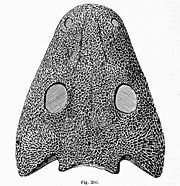
Skull roof
Encyclopedia
The skull roof , or the roofing bones of the skull
are a set of bone
s covering the brain
, eye
s and nostril
s in bony fishes and all land living vertebrates. The bones are derived from dermal bone
, hence the alternative name dermatocranium. More or less incorporated in the skull roof is the upper jaw
and the endocranium
.
 The early armoured fish
The early armoured fish
did not have a skull in the common understanding of the word, but had an endocranium
that was partially open above, topped by dermal bone
s forming armour
. The dermal bones gradually evolved
into a fixed unit overlaying the endocranium like a heavy "lid", protecting the animals head and brain from above. Cartilaginous fish
whose skeleton is formed from cartilage
lack a continuous dermal armour and thus has no proper skull roof. A more or less full shield of fused dermal bone
s was common in early bony fishes
of the Devonian
, and particularly well developed in shallow water species.
 In early sarcopterygian
In early sarcopterygian
s the skull roof was composed of numerous bony plates, particularly around the nostrils and behind each eye. The skull proper was joined by the bones of the operculum
. The skull itself was composed rather loosely, with a joint between the bones covering the brain (the parietal bone
s and the bones behind them) and the snout (the frontal bone
, nasal bone
and the bones in front and to the side of them). This joint disappeared in the evolving labyrinthodonts
, at the same time the number of bones were reduced and the operculum disappeared.
In modern amphibians the skull roof is further reduced and has large openings. Only in caecilian
s can a full covering skull roof be found, an adaption for burrowing.
In skull roof in lungfish
is composed of a number of bony plates that that are nor readily compared to those found in early amphibians. In most ray-finned fishes
the skull is often reduced to a series of loose elements, and a skull roof as such is not found.
 The pattern of plates of the labyrinthodonts
The pattern of plates of the labyrinthodonts
formed that basis for that seen in all land-living vertebrates. The roof itself formed a continuous cover over the whole of the head, leaving only openings for nostrils, eyes and a parietal eye
between the parietal bone
s. This type of skull was inherited by the first reptiles as they evolved from labyrinthodont stock in the Carboniferous
. This type of skull roof without any above openings behind the eyes is called anapsid
. Today anapsid skulls are only found in turtle
s, though this may be a case of secondary loss of the post orbital openings, see Parareptilia
.
s having one opening on each side, fairly low on the side of the skull, between the zygomatic bone
and the elements above, and the Diapsid
s having two openings on each side, the two openings separated by an arch formed from processes of the postorbital and squamosal
bones. The synapsids are the mammal-like reptiles and the mammal
s. In mammals, the side opening is closed by the sphenoid bone
, so that the skull roof appear whole, despite the temporal opening. All other reptiles (with the possible exception of turtles) and the bird
s are diapsids.
Skull
The skull is a bony structure in the head of many animals that supports the structures of the face and forms a cavity for the brain.The skull is composed of two parts: the cranium and the mandible. A skull without a mandible is only a cranium. Animals that have skulls are called craniates...
are a set of bone
Bone
Bones are rigid organs that constitute part of the endoskeleton of vertebrates. They support, and protect the various organs of the body, produce red and white blood cells and store minerals. Bone tissue is a type of dense connective tissue...
s covering the brain
Brain
The brain is the center of the nervous system in all vertebrate and most invertebrate animals—only a few primitive invertebrates such as sponges, jellyfish, sea squirts and starfishes do not have one. It is located in the head, usually close to primary sensory apparatus such as vision, hearing,...
, eye
Eye
Eyes are organs that detect light and convert it into electro-chemical impulses in neurons. The simplest photoreceptors in conscious vision connect light to movement...
s and nostril
Nostril
A nostril is one of the two channels of the nose, from the point where they bifurcate to the external opening. In birds and mammals, they contain branched bones or cartilages called turbinates, whose function is to warm air on inhalation and remove moisture on exhalation...
s in bony fishes and all land living vertebrates. The bones are derived from dermal bone
Dermal bone
A dermal bone - bony structures derived from intramembranous ossification that form components of the vertebrate skeleton including the skull, jaws, gills, fins and exoskeleton. In contrast to endochondral bone, dermal bone does not form from cartilage first and then calcify...
, hence the alternative name dermatocranium. More or less incorporated in the skull roof is the upper jaw
Maxilla
The maxilla is a fusion of two bones along the palatal fissure that form the upper jaw. This is similar to the mandible , which is also a fusion of two halves at the mental symphysis. Sometimes The maxilla (plural: maxillae) is a fusion of two bones along the palatal fissure that form the upper...
and the endocranium
Endocranium
For internal cast of the cranium, see Endocast.The endocranium in comparative anatomy is a part of the skull base in vertebrates and represent the basal, inner part of the cranium. The term is also applied to the outer layer of the dura mater in human anatomy.-Basic structure:Structurally, the...
.
Origin

Ostracoderm
Ostracoderms are any of several groups of extinct, primitive, jawless fishes that were covered in an armor of bony plates. They belong to the taxon Ostracodermi, and their fossils are found in the Ordovician and Devonian Period strata of North America and Europe...
did not have a skull in the common understanding of the word, but had an endocranium
Endocranium
For internal cast of the cranium, see Endocast.The endocranium in comparative anatomy is a part of the skull base in vertebrates and represent the basal, inner part of the cranium. The term is also applied to the outer layer of the dura mater in human anatomy.-Basic structure:Structurally, the...
that was partially open above, topped by dermal bone
Dermal bone
A dermal bone - bony structures derived from intramembranous ossification that form components of the vertebrate skeleton including the skull, jaws, gills, fins and exoskeleton. In contrast to endochondral bone, dermal bone does not form from cartilage first and then calcify...
s forming armour
Armour (zoology)
Armour in animals is external or superficial protection against attack by predators, formed as part of the body , usually through the hardening of body tissues, outgrowths or secretions. It has therefore mostly developed in 'prey' species...
. The dermal bones gradually evolved
Evolution
Evolution is any change across successive generations in the heritable characteristics of biological populations. Evolutionary processes give rise to diversity at every level of biological organisation, including species, individual organisms and molecules such as DNA and proteins.Life on Earth...
into a fixed unit overlaying the endocranium like a heavy "lid", protecting the animals head and brain from above. Cartilaginous fish
Chondrichthyes
Chondrichthyes or cartilaginous fishes are jawed fish with paired fins, paired nares, scales, two-chambered hearts, and skeletons made of cartilage rather than bone...
whose skeleton is formed from cartilage
Cartilage
Cartilage is a flexible connective tissue found in many areas in the bodies of humans and other animals, including the joints between bones, the rib cage, the ear, the nose, the elbow, the knee, the ankle, the bronchial tubes and the intervertebral discs...
lack a continuous dermal armour and thus has no proper skull roof. A more or less full shield of fused dermal bone
Dermal bone
A dermal bone - bony structures derived from intramembranous ossification that form components of the vertebrate skeleton including the skull, jaws, gills, fins and exoskeleton. In contrast to endochondral bone, dermal bone does not form from cartilage first and then calcify...
s was common in early bony fishes
Osteichthyes
Osteichthyes , also called bony fish, are a taxonomic group of fish that have bony, as opposed to cartilaginous, skeletons. The vast majority of fish are osteichthyes, which is an extremely diverse and abundant group consisting of over 29,000 species...
of the Devonian
Devonian
The Devonian is a geologic period and system of the Paleozoic Era spanning from the end of the Silurian Period, about 416.0 ± 2.8 Mya , to the beginning of the Carboniferous Period, about 359.2 ± 2.5 Mya...
, and particularly well developed in shallow water species.
Bony fishes and amphibians

Sarcopterygii
The Sarcopterygii or lobe-finned fishes – sometimes considered synonymous with Crossopterygii constitute a clade of the bony fishes, though a strict classification would include the terrestrial vertebrates...
s the skull roof was composed of numerous bony plates, particularly around the nostrils and behind each eye. The skull proper was joined by the bones of the operculum
Operculum (fish)
The operculum of a bony fish is the hard bony flap covering and protecting the gills. In most fish, the rear edge of the operculum roughly marks the division between the head and the body....
. The skull itself was composed rather loosely, with a joint between the bones covering the brain (the parietal bone
Parietal bone
The parietal bones are bones in the human skull which, when joined together, form the sides and roof of the cranium. Each bone is roughly quadrilateral in form, and has two surfaces, four borders, and four angles. It is named from the Latin pariet-, wall....
s and the bones behind them) and the snout (the frontal bone
Frontal bone
The frontal bone is a bone in the human skull that resembles a cockleshell in form, and consists of two portions:* a vertical portion, the squama frontalis, corresponding with the region of the forehead....
, nasal bone
Nasal bone
The nasal bones are two small oblong bones, varying in size and form in different individuals; they are placed side by side at the middle and upper part of the face, and form, by their junction, "the bridge" of the nose.Each has two surfaces and four borders....
and the bones in front and to the side of them). This joint disappeared in the evolving labyrinthodonts
Labyrinthodontia
Labyrinthodontia is an older term for any member of the extinct subclass of amphibians, which constituted some of the dominant animals of Late Paleozoic and Early Mesozoic times . The group is ancestral to all extant landliving vertebrates, and as such constitutes an evolutionary grade rather...
, at the same time the number of bones were reduced and the operculum disappeared.
In modern amphibians the skull roof is further reduced and has large openings. Only in caecilian
Caecilian
The caecilians are an order of amphibians that superficially resemble earthworms or snakes. They mostly live hidden in the ground, making them the least familiar order of amphibians. All extant caecilians and their closest fossil relatives are grouped as the clade Apoda. They are mostly...
s can a full covering skull roof be found, an adaption for burrowing.
In skull roof in lungfish
Lungfish
Lungfish are freshwater fish belonging to the Subclass Dipnoi. Lungfish are best known for retaining characteristics primitive within the Osteichthyes, including the ability to breathe air, and structures primitive within Sarcopterygii, including the presence of lobed fins with a well-developed...
is composed of a number of bony plates that that are nor readily compared to those found in early amphibians. In most ray-finned fishes
Actinopterygii
The Actinopterygii or ray-finned fishes constitute a class or sub-class of the bony fishes.The ray-finned fishes are so called because they possess lepidotrichia or "fin rays", their fins being webs of skin supported by bony or horny spines , as opposed to the fleshy, lobed fins that characterize...
the skull is often reduced to a series of loose elements, and a skull roof as such is not found.
Labyrinthodonts and early reptiles

Labyrinthodontia
Labyrinthodontia is an older term for any member of the extinct subclass of amphibians, which constituted some of the dominant animals of Late Paleozoic and Early Mesozoic times . The group is ancestral to all extant landliving vertebrates, and as such constitutes an evolutionary grade rather...
formed that basis for that seen in all land-living vertebrates. The roof itself formed a continuous cover over the whole of the head, leaving only openings for nostrils, eyes and a parietal eye
Parietal eye
A parietal eye, also known as a parietal organ or third-eye or pineal eye, is a part of the epithalamus present in some animal species...
between the parietal bone
Parietal bone
The parietal bones are bones in the human skull which, when joined together, form the sides and roof of the cranium. Each bone is roughly quadrilateral in form, and has two surfaces, four borders, and four angles. It is named from the Latin pariet-, wall....
s. This type of skull was inherited by the first reptiles as they evolved from labyrinthodont stock in the Carboniferous
Carboniferous
The Carboniferous is a geologic period and system that extends from the end of the Devonian Period, about 359.2 ± 2.5 Mya , to the beginning of the Permian Period, about 299.0 ± 0.8 Mya . The name is derived from the Latin word for coal, carbo. Carboniferous means "coal-bearing"...
. This type of skull roof without any above openings behind the eyes is called anapsid
Anapsid
An anapsid is an amniote whose skull does not have openings near the temples.While "anapsid reptiles" or "anapsida" are traditionally spoken of as if they were a monophyletic group, it has been suggested that several groups of reptiles that had anapsid skulls may be only distantly related...
. Today anapsid skulls are only found in turtle
Turtle
Turtles are reptiles of the order Testudines , characterised by a special bony or cartilaginous shell developed from their ribs that acts as a shield...
s, though this may be a case of secondary loss of the post orbital openings, see Parareptilia
Parareptilia
Parareptilia is a subclass or clade of reptiles which is variously defined as an extinct group of primitive anapsids, or a more cladistically correct alternative to Anapsida...
.
Diapsids and synapsids
In two groups of early reptiles the skull roof evolved post orbital openings to allow for greater movement of the jaw muscles. The two groups evolved the openings independently: The SynapsidSynapsid
Synapsids are a group of animals that includes mammals and everything more closely related to mammals than to other living amniotes. They are easily separated from other amniotes by having an opening low in the skull roof behind each eye, leaving a bony arch beneath each, accounting for their name...
s having one opening on each side, fairly low on the side of the skull, between the zygomatic bone
Zygomatic bone
The zygomatic bone is a paired bone of the human skull. It articulates with the maxilla, the temporal bone, the sphenoid bone and the frontal bone. The zygomatic is homologous to the jugal bone of other tetrapods...
and the elements above, and the Diapsid
Diapsid
Diapsids are a group of reptiles that developed two holes in each side of their skulls, about 300 million years ago during the late Carboniferous period. Living diapsids are extremely diverse, and include all crocodiles, lizards, snakes, and tuatara...
s having two openings on each side, the two openings separated by an arch formed from processes of the postorbital and squamosal
Squamosal
The squamosal is a bone of the head of higher vertebrates. It is the principal component of the cheek region in the skull, lying below the temporal series and otic notch and bounded anteriorly by postorbital. Posteriorly, the squamosal articulates with the posterior elements of the palatal complex,...
bones. The synapsids are the mammal-like reptiles and the mammal
Mammal
Mammals are members of a class of air-breathing vertebrate animals characterised by the possession of endothermy, hair, three middle ear bones, and mammary glands functional in mothers with young...
s. In mammals, the side opening is closed by the sphenoid bone
Sphenoid bone
The sphenoid bone is an unpaired bone situated at the base of the skull in front of the temporal bone and basilar part of the occipital bone.The sphenoid bone is one of the seven bones that articulate to form the orbit...
, so that the skull roof appear whole, despite the temporal opening. All other reptiles (with the possible exception of turtles) and the bird
Bird
Birds are feathered, winged, bipedal, endothermic , egg-laying, vertebrate animals. Around 10,000 living species and 188 families makes them the most speciose class of tetrapod vertebrates. They inhabit ecosystems across the globe, from the Arctic to the Antarctic. Extant birds range in size from...
s are diapsids.

